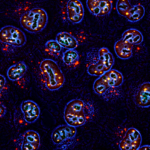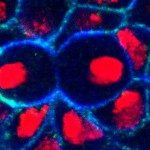Link to Pubmed [PMID] – 10629064
Mol. Cell. Biol. 2000 Feb;20(3):1072-82
The ubiquitin-related SUMO-1 modifier can be covalently attached to a variety of proteins. To date, four substrates have been characterized in mammalian cells: RanGAP1, IkappaBalpha, and the two nuclear body-associated PML and Sp100 proteins. SUMO-1 modification has been shown to be involved in protein localization and/or stabilization and to require the activity of specialized E1-activating and E2 Ubc9-conjugating enzymes. SUMO-1 homologues have been identified in various species and belong to the so-called Smt3 family of proteins. Here we have characterized the Drosophila homologues of mammalian SUMO-1 and Ubc9 (termed dSmt3 and dUbc9, respectively). We show that dUbc9 is the conjugating enzyme for dSmt3 and that dSmt3 can covalently modify a number of proteins in Drosophila cells in addition to the human PML substrate. The dSmt3 transcript and protein are maternally deposited in embryos, where the protein accumulates predominantly in nuclei. Similar to its human counterpart, dSmt3 protein is observed in a punctate nuclear pattern. We demonstrate that Tramtrack 69 (Ttk69), a repressor of neuronal differentiation, is a bona fide in vivo substrate for dSmt3 conjugation. Finally, we show that both the modified and unmodified forms of Ttk69 can bind to a Ttk69 binding site in vitro. Moreover, dSmt3 and Ttk69 proteins colocalize on polytene chromosomes, indicating that the dSmt3-conjugated Ttk69 species can bind at sites of Ttk69 action in vivo. Altogether, these data indicate a high conservation of the Smt3 conjugation pathway and further suggest that this mechanism may play a role in the transcriptional regulation of cell differentiation in Drosophila flies.

